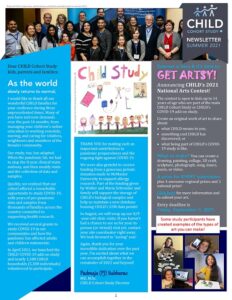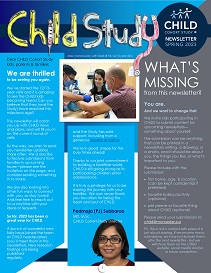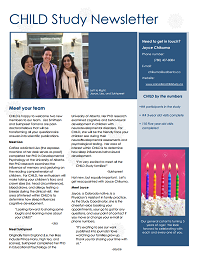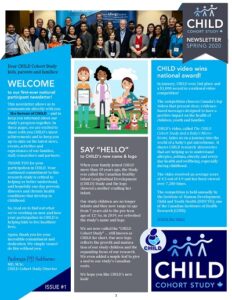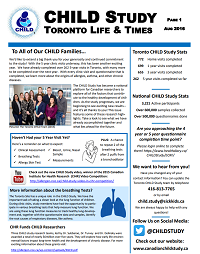Overview
The Schroeder Allergy and Immunology Research Institute’s Prevention Pathway involves a prospective, longitudinal birth cohort study known as the CHILD Cohort Study (CHILD). The study is following nearly 3,500 children, and their parents, over time as they grow and develop – from mid-pregnancy into childhood and adolescence.
CHILD is the largest multicentre, longitudinal, population-based birth cohort study in Canada and is designed to be one of the most informative studies of its kind in the world. It involves clinician-scientists from four recruitment sites located in Vancouver, Edmonton, Winnipeg (urban and rural communities) and Toronto.
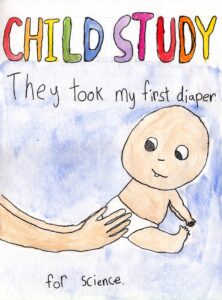 As a longitudinal study, CHILD has been gathering data and biological samples from the participating children and their families at specific points throughout their childhood and now into their teen years. The data collected by CHILD includes information on childhood health and nutrition, family histories of allergies and the results of clinical tests for things such as allergic sensitivity and lung health. Biological samples collected include dust from house inspections, breast milk, blood, urine, baby teeth and stool.
As a longitudinal study, CHILD has been gathering data and biological samples from the participating children and their families at specific points throughout their childhood and now into their teen years. The data collected by CHILD includes information on childhood health and nutrition, family histories of allergies and the results of clinical tests for things such as allergic sensitivity and lung health. Biological samples collected include dust from house inspections, breast milk, blood, urine, baby teeth and stool.
CHILD has already generated numerous significant scientific insights into the developmental origins of asthma, allergy and other diseases, including obesity and diabetes. It has also shed light on the vital influence of the microbiome on human health outcomes.
A principal aim of the Prevention Pathway is, by leveraging CHILD’s vast datasets, to inform the prevention of allergic disease through a deeper understanding of biological and environmental early-life factors associated with its development. These insights will inform translational mechanistic studies (pre-clinical, animal model and clinical) in the Treatment Pathway.
Some of Canada’s leading data scientists and bioinformaticians are currently helping CHILD design a relational database to facilitate analysis of the unique CHILD data. Using this database, institute scientists will interrogate the data in novel ways and generate ground-breaking insights to improve the health and wellbeing of Canadians for generations to come.
Research Advancement
 Schroeder Allergy and Immunology Research Institute’s (SAIRI) Prevention Pathway is informing approaches to the prevention of allergic disease by identifying early-life factors associated with its development.
Schroeder Allergy and Immunology Research Institute’s (SAIRI) Prevention Pathway is informing approaches to the prevention of allergic disease by identifying early-life factors associated with its development.
The Prevention Pathway has generated novel data, resulting in numerous publications and clinically important findings that have captured international attention. The study’s vast datasets have become a critical platform for studies of development of health and disease, supporting an increasing number of major research projects.
Contributions to research by the Prevention Pathway

The Prevention Pathway has collected detailed environmental and health information from study participants at 12 different time points from mid-pregnancy to eight years, with more data being collected at age 12 and beyond. No similar study has analyzed the home environment of such a large pregnancy-based cohort at the same level of detail, with “environment” interpreted broadly to include physical, chemical, viral, bacterial, nutritional and psychosocial exposures. Other data collected by questionnaires include mode of delivery, duration and exclusivity of breastfeeding, use of daycare, exposures to medications (especially antibiotics), maternal diet during pregnancy and infant/child diet and growth.
Despite COVID-related lockdowns and delays, researchers completed the study’s fourth major data collection phase with the children’s eight-year clinic visit in December 2021, realizing 83% of all eligible visits for this age group. The 12-year-old clinical visits with study participants began in all four study sites in August 2022.
With participating youth now reaching the critical years of adolescence, it is a pivotal time for the study. From this round of data collection and clinical visits, we anticipate gaining insight into changes in health and development that accompany puberty and the early teen years. We are particularly interested in the ‘gender shift’ that occurs in asthma, as asthma is more prevalent in boys before puberty and in women after puberty. We have also expanded our protocols to collect information pertinent to this phase of life, including things like gender identity, screen time and mental health.
– Dr. Padmaja Subbarao, CHILD Director
Within the 12-year visits, researchers are collecting extensive questionnaire responses, physical assessment data and test results (lung function, allergy, body composition), as well as biological samples of urine, nasal tissue, stool, teeth and blood. The study is also continuing to collect actigraph data with which to study children’s sleep and activity patterns, and GPS data to evaluate the children’s environmental exposures.

The Prevention Pathway will continue conducting 12-year clinical visits at its four sites across Canada over the next three years to collect data from as many of the almost 3,500 participating kids as possible. Planning is also underway for the following round of data collection, when the participating youth will be 15/16 years old.
“I’m happy to be in the study. It’s fun,” says Lucas from Edmonton, two months shy of his twelfth birthday at the time of his visit: “I can help researchers prevent childhood diseases and I’m good with coming back at 15 years.”
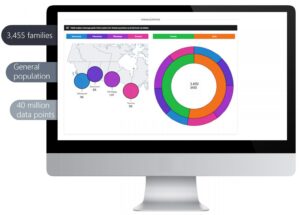
The Prevention Pathway’s wealth of longitudinal environmental, immunological, physiologic and genetic data allows for both traditional and novel strategies of data analysis to test novel hypotheses related to the developmental origins of allergy and other diseases.
CHILDdb, the Prevention Pathway’s interactive online database, provides an unprecedented opportunity for researchers to explore study data to investigate genetic and environmental factors influencing child health, including the development of allergic disease.
CHILDdb uses standardized data definitions and transparent data dictionaries to increase the utility and power of its datasets and maximize opportunities for collaboration. Users can search and explore over 67 million data points, comprising 465 questionnaires, over 51,000 variables, plus 14 additional large-scale datasets, and to review descriptions of biological samples available for analysis – all collected across 13 time points from pregnancy to eight years of age. Researchers can create an account to view meta and aggregate data, access demographic data summaries based on selected variables and submit a scientific Concept Proposal for approval to access individual-level study data.
The powerful search interface allows users to search for data related to their research (e.g., ‘asthma’, ‘allergy’). A forthcoming update will add the new Elasticsearch engine that allows complex, Google-like searching. The system also allows the user to facet their search, filtering results by visit (‘five-year’, ‘birth’), type (‘questionnaire’, ‘analytes’), category (‘child medications’, ‘home environment’) and cohort. Users can also click into the variable response distributions, to review the way study participants have responded to specific questions overall, providing an overview of the data they are interested in before requesting to download the entire dataset.
CHILDdb is already a valuable national resource that will increasingly empower novel research as additional data is collected and integrated in the years ahead.

Since the initiation of the Prevention Pathway, the study has collected a treasure trove of biological samples from cohort participants, including breastmilk, urine, nasal tissue, stool, and blood. However, the interval from sample collection to final analysis and scientific publication can range from three-to-five years and beyond.
With SAIRI support, the researchers have been able to store the study’s extensive biological samples at the Clinical Research Laboratory and Biobank (CRLB) in Hamilton, Ontario. The samples are stored in nitrogen vapour at -160°C to -180°C for long-term stability and to ensure the greatest preservation of biomarkers, which are crucial to enable future research discoveries.
SAIRI also supports the cost of removing samples from storage and shipping them to investigators who have been approved to work with the Prevention Pathway.
Prior to the Schroeder funding, researchers struggled to raise the annual funds required to maintain and protect the study’s sensitive biological samples. Without a stable source of funding, this precious resource was in peril of being destroyed, which would have represented a catastrophic loss to the scientific community.
SAIRI support for Prevention Pathway research projects enables the securing of additional sources of funding. Many research funding agencies require that applicants demonstrate additional sources of support for their proposed project. By bringing SAIRI support to the table, researchers are able to fulfill that requirement and become eligible for additional grants.
For example, SAIRI support enabled Prevention Pathway coordinator Dr. Padmaja Subbarao to secure a Canadian Institutes of Health Research (CIHR) project grant in 2021, which will partially cover costs of the 12-year clinical visits. The five-year grant, valued at over $1.2 million, aims to study childhood lung function and blood pressure to see if these measures are related to asthma and changes (stiffness) in the vessels at 13 years of age. With this information, researchers hope to better understand how respiratory and cardiovascular diseases develop in early life, leading to new and earlier ways of how to prevent these chronic disorders.
The funding also assisted the study’s deputy director, Dr. Meghan Azad, to secure a prestigious $2.5M grant from the US National Institutes of Health (NIH) in 2023 to enable a five-year study that will leverage samples of breastmilk preserved in storage at the study’s outset, together with the data collected since.
Having access to that kind of data over a long period is unique. The children are now 12 or 13 years old and we’re still following them. That’s really unique as a resource.
– Dr. Meghan Azad, CHILD Deputy Director
The study’s uniqueness explains the awarding of the grant to a Canadian researcher, given that the NIH only supports international research when the work cannot be accomplished in the US.
“We have the potential, in this project, to link everything we find in the breastmilk to health outcomes in the children. We’re going to generate the world’s largest and most detailed dataset of mothers, infants and breastmilk,” adds Dr. Azad.
The Prevention Pathway is answering questions about the origins of chronic diseases, including allergic disease, and identifying early life “critical windows” to build healthier futures.
 The Prevention Pathway has generated novel data in the early years of follow-up with its subjects, resulting in numerous publications and clinically important findings that have captured international attention. Its findings are influencing medical practice, parenting choices, consumer product regulation and policy development, from building codes and household purchasing behaviours to decisions about childbirth and delivery, diet, breastfeeding, cleaning products used in homes, owning a family pet and dealing with stress.
The Prevention Pathway has generated novel data in the early years of follow-up with its subjects, resulting in numerous publications and clinically important findings that have captured international attention. Its findings are influencing medical practice, parenting choices, consumer product regulation and policy development, from building codes and household purchasing behaviours to decisions about childbirth and delivery, diet, breastfeeding, cleaning products used in homes, owning a family pet and dealing with stress.
The new knowledge the pathway generates is translated to the scientific community, the public and other stakeholders by various means:
- Over 180 articles in leading peer-reviewed journals including the Journal of Allergy and Clinical Immunology, Lancet Respiratory Medicine, Clinical & Experimental Allergy, Pediatric Allergy and Immunology, Allergy, Frontiers in Immunology, JAMA Pediatrics, and Journal of Translational Medicine, among others.
- Press releases and media coverage in major outlets such as The New York Times, CBC, The Globe and Mail, Newsweek, The Toronto Star, Chatelaine, McLean’s Magazine and The Economist, among others.
- Portable communications pieces including one-page lay summaries and infographics, available through the “Key Discoveries” section of the study’s website and a symptom-based asthma screening tool for clinical use
- Short animated videos, a number of which have won knowledge translation awards from CIHR
- Citation in guidelines and policy papers by public and non-governmental health and children’s welfare organizations such as the World Health Organization (WHO), COVID-19 Immunity Task Force (CITF), Children First Canada, and UNICEF
Participant Engagement
 The families participating in the CHILD Cohort Study are the true heroes of the Prevention Pathway.
The families participating in the CHILD Cohort Study are the true heroes of the Prevention Pathway.
Without their dedication and willingness to spend hours answering questionnaires and subjecting themselves to physical exams, which entail such things as blood draws, lung function tests and allergy skin prick tests, none of the advances the pathway is achieving would be possible. For this reason, pathway staff and researchers proactively work toward ensuring these families feel recognized and appreciated, and have the opportunity to contribute to the study’s progress.
Participant engagement in the Prevention Pathway
The Prevention Pathway has organized various social and educational events to celebrate and engage participating families, and to share with them outcomes of the cohort study, including:
- Movie nights at the four study sites across the country, during which the documentary feature film “Let Them Eat Dirt” was screened, highlighting microbiome-related findings from the study.
- Events with educational posters, activities and speakers to celebrate the study’s having completed its originally proposed endpoint of completing clinical visits with all participants at five years of age.
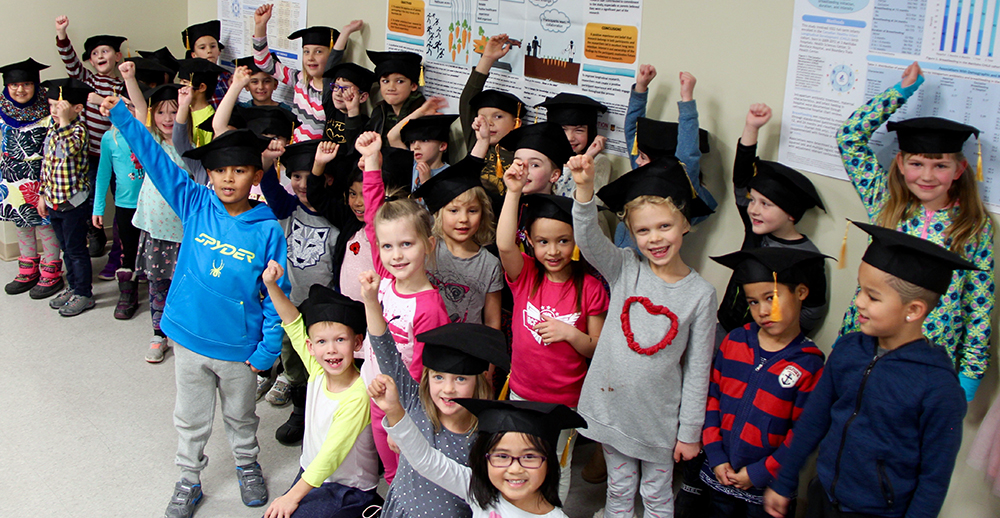
Movie night in Vancouver: a short video
Poster and Arts Contests: In 2019 and 2021, the Prevention Pathway held contests for participating youth to design an informational poster about the study and to create a work of artistic expression, in any medium, about the study and their involvement in it, respectively.
Dozens of participating kids submitted an amazing array of work that was judged by a panel of prominent professionals active in fields related to youth welfare, health and empowerment, with special prizes for the top three submissions and smaller gifts for everyone who participated.
The artwork submitted has been used extensively to illustrate reports, newsletters and other communications products (including this website) designed by the Prevention Pathway and kindred organizations.
Learn about the submissions in the 2021 Arts Contest and the 2019 Poster Contest.
Video of the song by Manitoba-based siblings Myla, Evynn and Presley, who won the national prize for the 2021 Arts Contest.
Winter Giveaway: In 2024, the Prevention Pathway hosted its first-ever Winter Giveaway Contest. Eight prizes were given away at each study site (five prizes for CHILD youth, three prizes for CHILD parents), and one grand prize was awarded at the national level.
Prizes included a 10th gen iPad, electric scooters, Beats headphones and various gift cards, including pre-paid VISA cards for prize-winning parents. To win prizes by draw in the Giveaway, families earned raffle tickets by undertaking Study-related activities (like booking and attending a CHILD clinic visit, completing questionnaires, or submitting biological samples). The more activities completed, the more entries in the draw.

Given the common challenge, among cohort studies, of engaging participants during adolescence, in 2023 and 2024 the Prevention Pathway implemented various strategies toward maximizing completion of 12-year visits and future participant retention.
Recruitment began for a Youth Council, being created to allow youth participants to contribute to Study planning and knowledge mobilization, interact regularly with Study leaders and researchers, and organize group activities aimed at building community among Study youth.
As an intial recruitment activity, in March 2024 youth participants across all four Study sites attended a “Virtual Spring Camp” where they interacted with study leaders and undertook team-building activities including a virtual Escape Room contest with prizes.
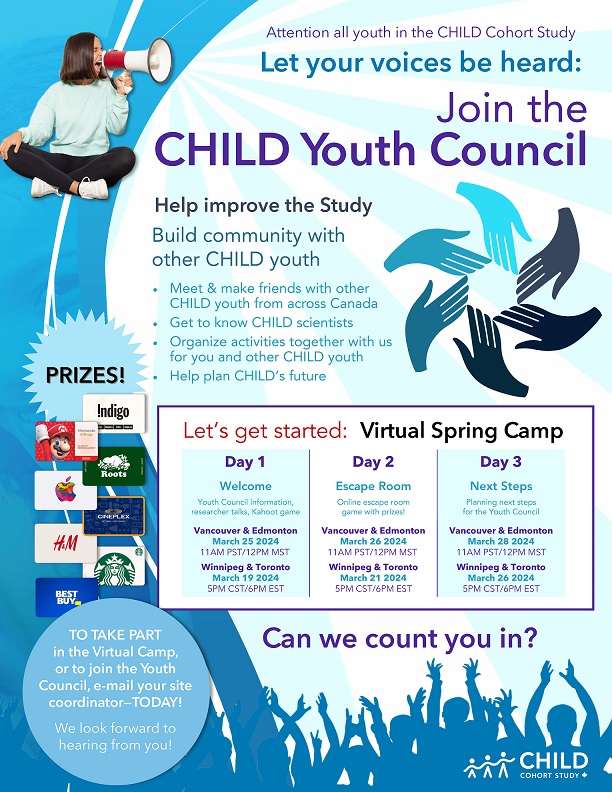
The Prevention Pathway’s National Participant Engagement Committee (NPEC) is a group of CHILD participant families (parents and children) who work together to help make the study a positive experience for all families across the country.
Their goal is to bring the research participant’s voice and perspectives to CHILD research and priorities. They give input on protocols for clinical visits and add-on studies (like the COVID-19 add-on study). help to plan and organize participant activities and provide ideas for sharing knowledge from the study with stakeholder groups near and far.
The NPEC is convened periodically to provide input to study planning processes and consulted in an ad hoc fashion by email. The NPEC families (children and adults) were participants in a panel on the Prevention Pathway at a national conference in Toronto in 2019, and in a strategic planning workshop in Kingsbridge in 2024.

NPEC families in British Columbia (Robert, Natasha and Max), in Manitoba (Eric, Harmoni and Lily), in Alberta (Tatiana, Sara, Lucas and Ruben) and in Ontario (Cara, Kat, Brynn and Aaron)
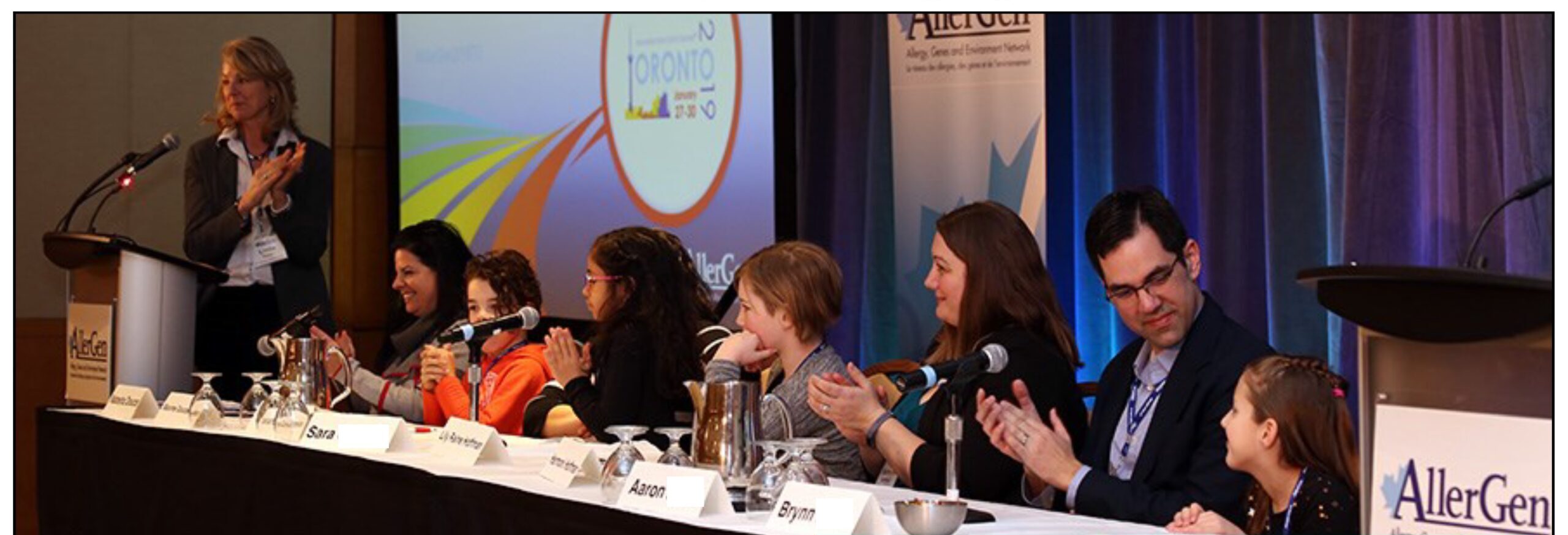
NPEC members answer questions from CHILD researchers at the 2019 AllerGen Conference, Toronto, ON.

NPEC members pose with CHILD researchers and staff at a July 2024 strategic planning workshop in Kingsbridge, ON.
The Prevention Pathway keeps study participants informed about study planning, activities and accomplishments through period newsletters issued at site-level, as well as nationally.
